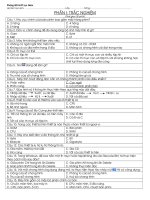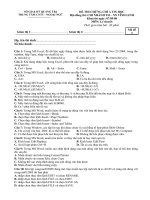Đề thi Tin học QT (IOI)2002-3
Bạn đang xem bản rút gọn của tài liệu. Xem và tải ngay bản đầy đủ của tài liệu tại đây (88.33 KB, 2 trang )
Task Description DAY-2
IOI 2002
Yong-In Version BA
Korea batch
Batch Scheduling
PROBLEM
There is a sequence of N jobs to be processed on one machine. The jobs are numbered
from 1 to N,. so that the sequence is 1,2, …, N. The sequence of jobs must be
partitioned into one or more batches, where each batch consists of consecutive jobs in
the sequence. The processing starts at time 0. The batches are handled one by one
starting from the first batch as follows. If a batch b contains jobs with smaller
numbers than batch c, then batch b is handled before batch c. The jobs in a batch are
processed successively on the machine. Immediately after all the jobs in a batch are
processed, the machine outputs the results of all the jobs in that batch. The output time
of a job j is the time when the batch containing j finishes.
A setup time S is needed to set up the machine for each batch. For each job i, we
know its cost factor F
i
and the time T
i
required to process it. If a batch contains the
jobs x, x+1, … , xy+-k1, y, and starts at time t, then the output time of every job in that
batch is t + S + (T
x
+ T
x+1
+ … + T
xy+-k1
+ T
y
). Note that the machine outputs the results
of all jobs in a batch at the same time. If the output time of job i is O
i
, its cost is O
i
×
F
i
. For example, assume that there are 5 jobs, the setup time S = 1, (T
1
, T
2
, T
3
, T
4
, T
5
) =
(1, 3, 4, 2, 1), and (F
1
, F
2
, F
3
, F
4
, F
5
) = (3, 2, 3, 3, 4). If the jobs are partitioned into
three batches {1, 2}, {3}, {4, 5}, then the output times (O
1
, O
2
, O
3
, O
4
, O
5
) = (5, 5, 10,
14, 14) and the costs of the jobs are (15, 10, 30, 42, 56), respectively. The total cost
for a partitioning is the sum of the costs of all jobs. The total cost for the example
partitioning above is 153.
You are to write a program which, given the batch setup time and a sequence of jobs
with their processing times and cost factors, computes the minimum possible total
cost.
INPUT
Your program reads from standard input. The first line contains the number of jobs N,
1 ≤ N ≤ 10000. The second line contains the batch setup time S which is an integer, 0
≤ S ≤ 50. The following N lines contain information about the jobs 1, 2, …, N in that
order as follows. First on each of these lines is an integer T
i
, 1 ≤ T
i
≤ 100, the
processing time of the job. Following that, there is an integer F
i
, 1 ≤ F
i
≤ 100, the cost
factor of the job.
OUTPUT
Your program writes to standard output. The output contains one line, which contains
one integer: the minimum possible total cost.
2014-07-02 5:25 Page 1 of 2
Task Description DAY-2
IOI 2002
Yong-In Version BA
Korea batch
EXAMPLE INPUTS AND OUTPUTS
Example 1: input output
Example 2: input output
Example 2 is the example in the text.
REMARK
For each test case, the total cost for any partitioning does not exceed 2
31
− 1.
SCORING
If your program outputs the correct answer for a test case within the time limit, then
you get full points for the test case, and otherwise you get 0 points.
2014-07-02 5:25 Page 2 of 2
5
1
1 3
3 2
4 3
2 3
1 4
153
2
50
100 100
100 100
45000









